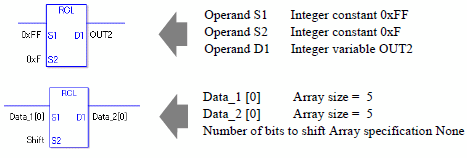
When the RCL or RCLP instruction is executed, the S1 bits are rotated to the left S2 number of bits. The bottom-most bit (the least most bit) is stored in a carry flag and the carry flag (1 or 0) is rotated to the topmost bit (the most significant bit).
The result is stored in D1. The RCL and RCLP instructions always pass power. When using the RCL and RCLP instructions, an error will occur if the variables specified in operands S1 and D1 are not the same type. Designate the same variable type in operands S1 and D1.
Refer to the following for specifying a constant.
S1: Rotation Address
Specify the address to rotate bits.
S2: Number of bits to rotate
Specifies the number of bits to rotate.
D1: Storage device
Specifies the address to store the rotation result.
For example, when 1 bit is rotated to left (with carry over)

When operand D1 is an integer variable

When operand D1 is an integer variable and you want to input hexadecimal values in operands S1 and S2.
When 0x (zero and lower case "x") is input, the following values become hexadecimal values.

If both S1 and D1 are not an array, 32 bits are rotated with carry over.
For S2, specify a value between 0 and 32.